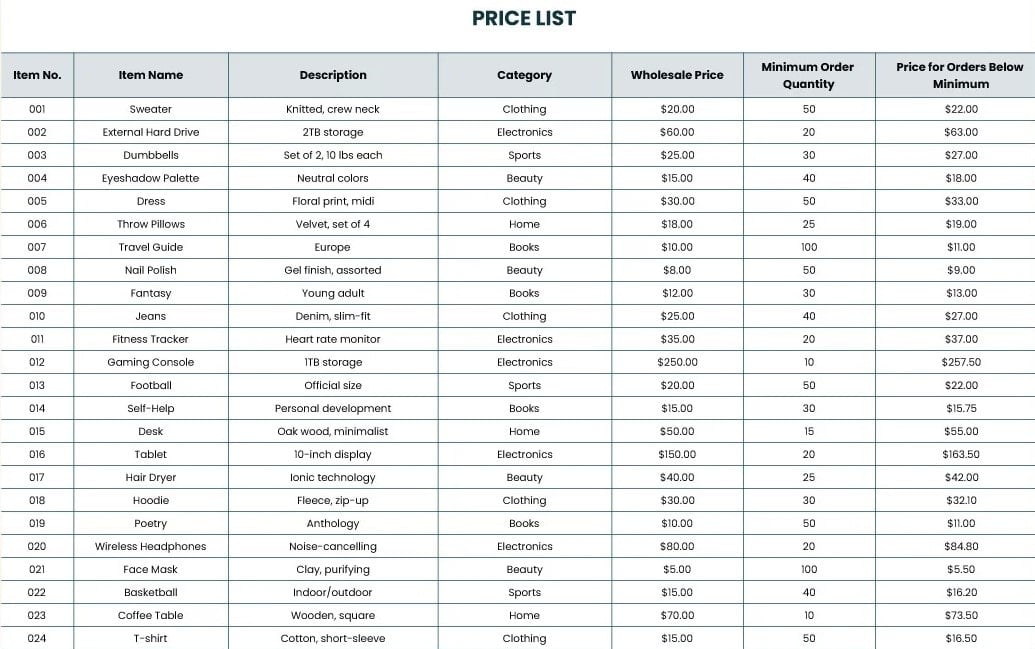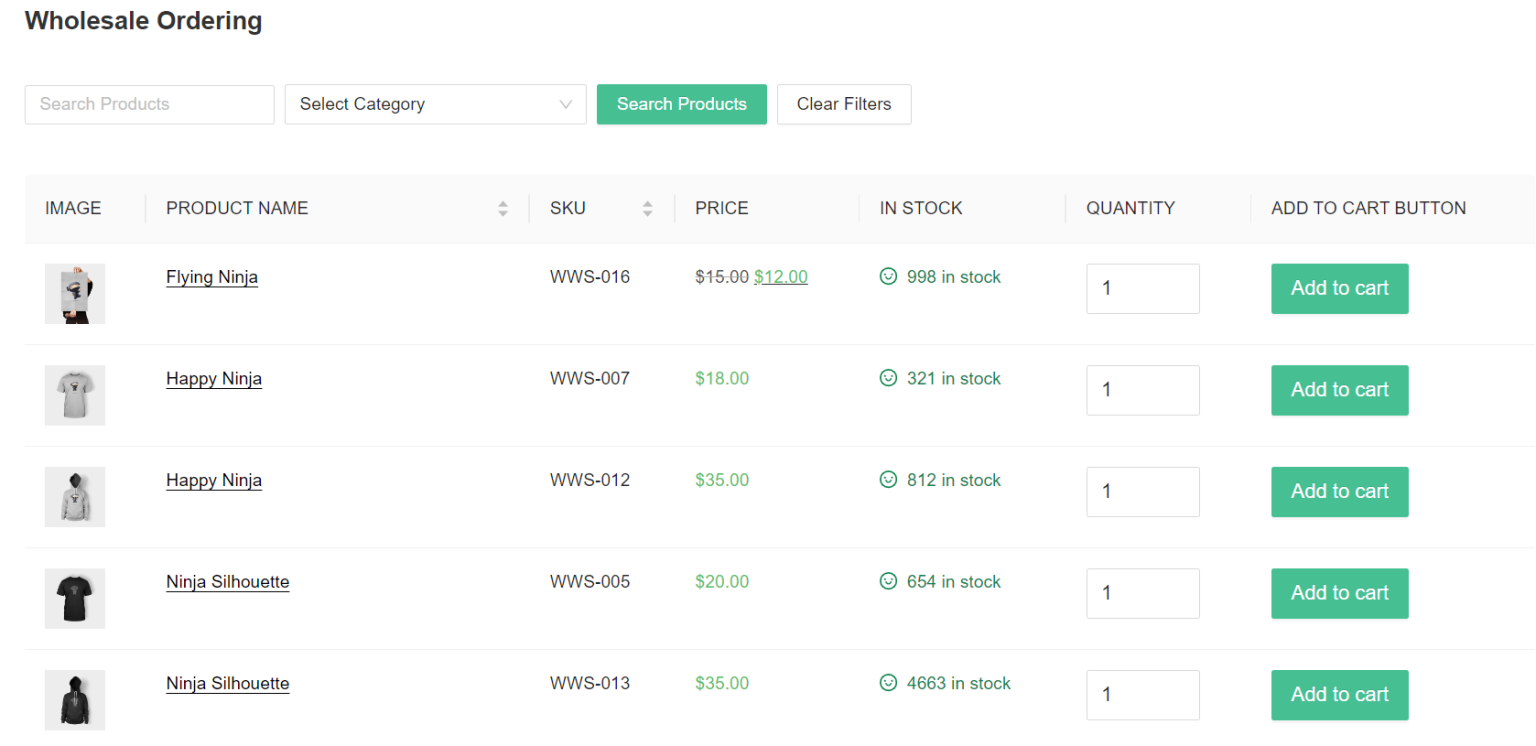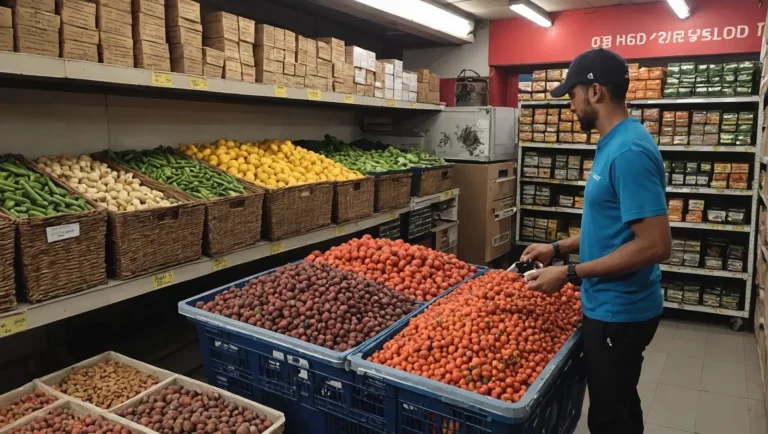Your wholesale price list is more than just a document—it’s a critical tool that can significantly impact your sales performance. A well-crafted list can help you attract bulk buyers, streamline ordering, and maximize profits. On the flip side, a poorly structured or overpriced list could turn potential customers away and undermine your business growth.
Creating the perfect wholesale price list requires more than just numbers. You need a strategic approach that incorporates effective pricing methods, considers market dynamics, and presents information in a clean, easy-to-navigate format. In this guide, we’ll walk you through the essentials of wholesale pricing, the most reliable tools for managing your list, and actionable steps to design a layout that not only looks professional but also drives sales. Plus, we’ve included a free, customizable template so you can hit the ground running. Discover strategies to avoid errors in wholesale pricing and boost your business’s earnings with our comprehensive guide.
Ready to optimize your pricing and boost your wholesale sales? Let’s get started!
Lower your delivery costs by 23%
How we reduce costs:
- No delivery vehicle expenses
- Optimized local routes
- Pay-per-delivery model
- Average 23% delivery cost reduction
Basics of Wholesale Pricing
Setting the right wholesale prices is one of the most critical steps to running a successful wholesale business. Unlike retail pricing, where you sell individual products directly to consumers, wholesale pricing typically involves selling products in bulk quantities to other businesses at a discounted rate. Wholesale customers then resell these products at retail prices. The key to successful wholesale pricing lies in finding a balance between covering your production costs and operating expenses, offering value to your wholesale customers, and still maintaining a healthy profit margin. Delve into the world of bulk pricing to master the delicate balance of setting compelling wholesale rates, ensuring your venture thrives through strategic price management.
The foundation of wholesale pricing is ensuring that your business remains profitable while staying competitive in the marketplace. This involves considering various pricing methods such as absorption pricing, which integrates overhead costs into the final price, or demand pricing, which adjusts prices based on market demand. By implementing a strong wholesale pricing strategy, you can set wholesale prices that attract wholesale buyers without sacrificing profit.
Understanding the Impact of Profit Margins on Wholesale Pricing
Profit margins are one of the most important factors in any pricing strategy, especially for businesses involved in wholesale. Essentially, a profit margin represents the difference between your cost price and the final selling price, after factoring in production costs and operating expenses. Achieving a reasonable profit margin ensures that your wholesale business remains viable and continues to grow.
In wholesale pricing, the gross profit margin typically ranges from 20% to 50%, depending on your industry. To calculate your gross profit margin, subtract the total material cost, total labor cost, and overhead costs from the final selling price, then divide the result by the selling price. The higher your gross profit margin, the more flexibility you have in offering competitive wholesale discounts, handling fluctuations in production costs, and adapting to changes in customer demand.
Additionally, when calculating wholesale prices, it’s essential to account for indirect costs such as rent, utilities, and marketing, as these affect your overall profitability. Whether you’re selling products online or through physical distribution channels, understanding how to calculate production costs and set prices with an appropriate profit margin is crucial. For businesses in metro areas like New York City, leveraging a reliable delivery partner can streamline logistics and improve customer satisfaction. Consider exploring a professional courier service in New York City to enhance your distribution operations and ensure timely deliveries, which are essential in maintaining strong relationships with wholesale customers.
While some businesses opt for higher profit margins to cover increased production costs, others adopt competitive pricing strategies, where they lower their prices to remain more attractive to wholesale customers. Offering bulk discounts or lower price points on specific products can also boost your sales volumes while maintaining a solid profit margin. Keeping a close eye on your profit margins allows you to make informed decisions about your pricing methods and adjust them when necessary.
Essential Considerations When Setting Wholesale Prices
When setting wholesale prices, you need to take several key factors into account to ensure your products are priced competitively, sustainably, and profitably. These considerations influence how you determine the final wholesale price list for your wholesale buyers and retail customers alike:
Production Costs: Your wholesale pricing should always start with the cost of production. This includes the cost of materials, labor, and any associated overheads, such as rent, utilities, and equipment. To calculate wholesale price accurately, ensure you’re aware of all expenses related to producing your goods, including hidden costs that may impact your bottom line. If you fail to account for your full production costs, you risk underpricing your wholesale products, which can lead to financial losses.
Profit Margins: Decide on your desired profit margin early in the pricing process. This will ensure that your wholesale prices allow you to generate enough profit to sustain and grow your business. If you aim for a gross profit margin of 40%, for example, you’ll need to calculate wholesale prices that reflect that margin while still remaining competitive in the market. Be sure to review your profit margins regularly, as changes in your production costs or market demand may require you to adjust your wholesale pricing accordingly.
Competitor Pricing: Conducting market research is essential to understanding how your pricing compares with that of your competitors. Competitor pricing can provide valuable insight into what other businesses are charging for similar products, and help you adjust your prices to stay competitive. Whether you’re using value-based pricing, which focuses on the perceived value of your product, or differentiated pricing, where you set different prices for different market segments, competitor analysis will inform your strategy.
Minimum Order Quantities (MOQ): For wholesale businesses, setting a minimum order quantity is a common practice. By establishing MOQs, you can ensure that your wholesale customers buy products in bulk quantities, helping you achieve higher sales volumes. MOQs also allow you to offer better wholesale discounts for large orders, which can incentivize your buyers to purchase more.
Bulk Discounts: Volume-based discounts can play a vital role in attracting wholesale buyers. Offering wholesale customers a lower price per unit for larger orders helps to increase sales and build stronger relationships with your customers. For example, you can offer a 10% discount on orders over 500 units, encouraging buyers to purchase in larger quantities while still ensuring your profit margins remain intact.
By incorporating these key considerations into your pricing strategy, you can set wholesale prices that meet the needs of both your business and your wholesale buyers. Understanding how to adjust your prices based on market demand, production costs, and competitor pricing will help you maintain a competitive advantage.
Metrobi is transforming wholesalers deliveries
Specialized solutions for wholesalers businesses:
- Wholesalers-trained drivers
- Proper handling equipment
- Peak day delivery support
- 23% average cost reduction
What Is A Wholesale Price List?
A wholesale price list is a structured document that outlines the prices of your products when sold in bulk to wholesale customers. Wholesale price lists are essential tools for wholesale businesses, as they allow you to communicate your pricing strategy to potential buyers and set expectations for minimum order quantities, discounts, and payment terms. Discover the power of bulk pricing and elevate your wholesale strategy to maximize efficiency and profitability.
Another crucial aspect of managing your wholesale business logistics is ensuring reliable delivery. Choosing the right logistics partner can simplify your operations significantly. For exemplary service, consider leveraging a trusted courier service in Los Angeles that understands the unique needs of wholesale delivery, ensuring your products reach customers promptly and safely.
For businesses operating in the Boston area, enhancing your supply chain with a dedicated Boston same-day delivery service can dramatically improve customer satisfaction and streamline your wholesale distribution. Fast, reliable delivery options ensure your products reach buyers swiftly, which can be a decisive factor in retaining repeat wholesale clients.
If you’re seeking more detailed information on how a dedicated Boston same-day delivery service can boost your wholesale operations, consider exploring Metrobi’s specialized courier solutions. Utilizing such services not only ensures rapid delivery but also enhances the reliability of your supply chain, which is vital for maintaining strong relationships with wholesale customers in the competitive Boston market.
Unlike retail price lists, which are designed for individual consumers, wholesale price lists are specifically tailored for businesses purchasing products in large quantities. This allows wholesalers to offer discounted prices while maintaining a healthy profit margin. A wholesale price list typically includes information such as the product name, description, wholesale price, recommended retail price (RRP), and any applicable discounts or promotional pricing.
A well-organized and clear wholesale price list not only helps you streamline your sales process but also ensures transparency between you and your wholesale customers. By providing detailed product prices and pricing methods upfront, you eliminate confusion and simplify negotiations with wholesale buyers.
Wholesale Price List Examples
There are two main types of wholesale price lists that businesses can use: manual wholesale price lists and online wholesale price lists. Each has its own advantages and is suitable for different types of businesses, depending on the scale of operations and customer preferences.
1. Manual Wholesale Price Lists
Manual wholesale price lists are typically created using spreadsheets or documents such as Excel or Google Sheets. These lists are often used by smaller businesses or those that deal with a limited number of wholesale buyers. A manual wholesale price list includes detailed product prices, minimum order quantities, and any applicable discounts.
The main advantage of manual price lists is their simplicity. They are easy to create and customize according to your specific business needs. However, they require frequent updates to reflect changes in production costs, product availability, or pricing strategies. For businesses with a large product catalog or a rapidly changing inventory, managing a manual price list can become time-consuming.
Despite these challenges, manual price lists remain a practical solution for businesses that need to provide clear and concise pricing information without investing in an automated system. They are also helpful for wholesalers who prefer to offer more personalized pricing to different buyers, as manual lists can be tailored for specific customers.
Here’s an example of a manual wholesale price list to show you how it looks:

2. Online Wholesale Price Lists
Online wholesale price lists are integrated directly into your e-commerce platform or website. They offer a more automated approach to managing wholesale pricing and allow your customers to view real-time prices, promotions, and product availability. This is especially useful for businesses that sell wholesale products through an online store. Enhance your pricing strategy by using our digital wholesale price calculator, where you can input your costs and decide on your profit margin to find the ideal pricing for your products.
One of the key benefits of an online wholesale price list is the ability to update prices automatically based on inventory levels, production costs, or changes in market demand. For example, if the cost of raw materials increases, you can quickly adjust your wholesale prices across all products without needing to manually update each item.
Additionally, online price lists make it easier to offer differentiated pricing to different customer groups, as you can create multiple price tiers based on order size, customer type, or other criteria. This flexibility allows you to cater to a wider range of wholesale buyers while ensuring that your pricing remains competitive.
Online wholesale price lists are ideal for businesses with a large product catalog or those that operate in fast-paced industries where pricing needs to be adjusted frequently. They offer convenience for both you and your wholesale customers by streamlining the buying process and providing real-time access to product prices.
Here’s an online wholesale price list example:

How to Create a Wholesale Price List?
Creating an effective wholesale price list requires careful planning and consideration of various factors, from pricing strategies to customer needs. Follow these five steps to ensure that your wholesale price list is comprehensive, clear, and aligned with your business goals.
1. Determine Your Pricing Strategy
The first step in creating a wholesale price list is to decide on your overall pricing strategy. This will serve as the foundation for how you set wholesale prices and ensure that your pricing is competitive and profitable. Some common pricing strategies include:
Cost-plus pricing: This is the most straightforward pricing method, where you add a fixed markup to your production costs to arrive at the wholesale price. This method ensures that you cover your production costs while still generating a reasonable profit margin.
Market-based pricing: In this strategy, you set your wholesale prices based on the going rates in the market. Conducting competitor research will help you understand how similar products are priced and allow you to position your products accordingly.
Value-based pricing: This approach focuses on the perceived value of your product to your wholesale customers. If your products offer unique benefits or superior quality, you may be able to charge a higher price, even if production costs are similar to lower-priced competitors.
Absorption pricing: This method includes overhead costs in the pricing of each product, ensuring that fixed costs such as rent and utilities are accounted for.
2. Calculate Your Production Costs
Once you have determined your pricing strategy, the next step is to calculate production costs. This includes both direct costs, such as materials and labor, and indirect costs, such as utilities, rent, equipment maintenance, and shipping. Understanding your total cost price is essential to ensure your wholesale price list covers all expenses while still allowing room for a healthy profit margin.
For example, if your total material cost for producing a product is $10, and labor and overhead costs are an additional $5, your cost price would be $15. From there, you can apply your desired markup to determine your wholesale price. If you aim for a 40% gross profit margin, your final selling price to wholesale buyers would need to be at least $25. Unlock the full potential of your product pricing strategy by understanding the nuances of pricing for wholesale markets. Learn the secrets and get access to a wholesale pricing calculator tool now.
It’s also crucial to factor in any volume-based discounts or bulk purchases when calculating production costs, as larger orders may reduce your per-unit costs. If your business offers lower price points for larger orders, ensure your pricing model can still cover operating expenses and generate a reasonable profit margin.
3. Set Wholesale Prices Based on Profit Margins
With your production costs in mind, the next step is to set your wholesale prices to achieve your target profit margins. As mentioned earlier, wholesale prices typically have lower margins than retail prices because wholesale buyers purchase in bulk quantities. However, setting wholesale prices requires striking a balance between covering costs, offering competitive prices, and maintaining a competitive advantage in the market.
For example, if your production cost is $15, and you want to achieve a reasonable profit margin of 40%, your unit gross profit should be at least $10. In this case, your wholesale price would be $25. If you aim to sell to retail customers as well, you can calculate the recommended retail price (RRP) based on your wholesale prices, usually by marking up the wholesale price by 50% or more.
Additionally, you may want to set differentiated prices depending on your wholesale buyers and wholesale customers. For instance, larger buyers may receive volume-based discounts, while smaller buyers may pay closer to your standard wholesale price.
4. Organize Your Wholesale Price List
Now that you’ve calculated your wholesale prices, the next step is to organize your price list in a clear and user-friendly format. A well-structured wholesale price list should be easy for your buyers to navigate and should include all necessary product details, such as:
Product name
SKU or product code
Wholesale price per unit
Minimum order quantity (MOQ)
Available discounts or promotional pricing
Recommended retail price (RRP)
You may also want to include additional information, such as shipping fees, payment terms, or lead times, depending on the specifics of your wholesale business. Keep in mind that a manual wholesale price list may need more frequent updates, while an online wholesale price list can be automated, making it easier to manage.
It’s also essential to provide a clear and transparent breakdown of your pricing tiers if you offer volume-based discounts. For example, you might offer a 10% discount for orders over 500 units or 15% for orders over 1,000 units. Presenting this information clearly in your wholesale price list helps your customers understand how they can maximize their savings by purchasing in larger quantities.
5. Update Your Wholesale Price List Regularly
Once your wholesale price list is created, it’s important to update it regularly to reflect changes in production costs, market demand, or competitor pricing. If your costs rise due to an increase in material or labor prices, or if you introduce new products to your lineup, you’ll need to adjust your wholesale prices accordingly.
Regular updates to your wholesale price list also help you stay competitive in the market. Conduct periodic market research to monitor changes in competitor pricing and adjust your wholesale pricing strategy if necessary. Additionally, keeping your online wholesale price list up-to-date ensures that wholesale customers always have access to accurate and current information.
Craft the Perfect Wholesale Price List to Drive Sales Growth
Setting the right wholesale prices and designing an effective price list are keys to boosting sales. We covered pricing strategies, essential elements for your list, tools you can use, and the importance of updates and feedback.
Clear and consistent price lists help build trust and streamline sales. Download our free template to get started right away. Explore different software options to find what fits your needs best. Take the time to regularly update your price lists and keep open lines of communication with your retailers.
What strategies will you implement first to optimize your wholesale price list?
Ready to elevate your wholesale game? Start today with our template and watch your sales grow.














